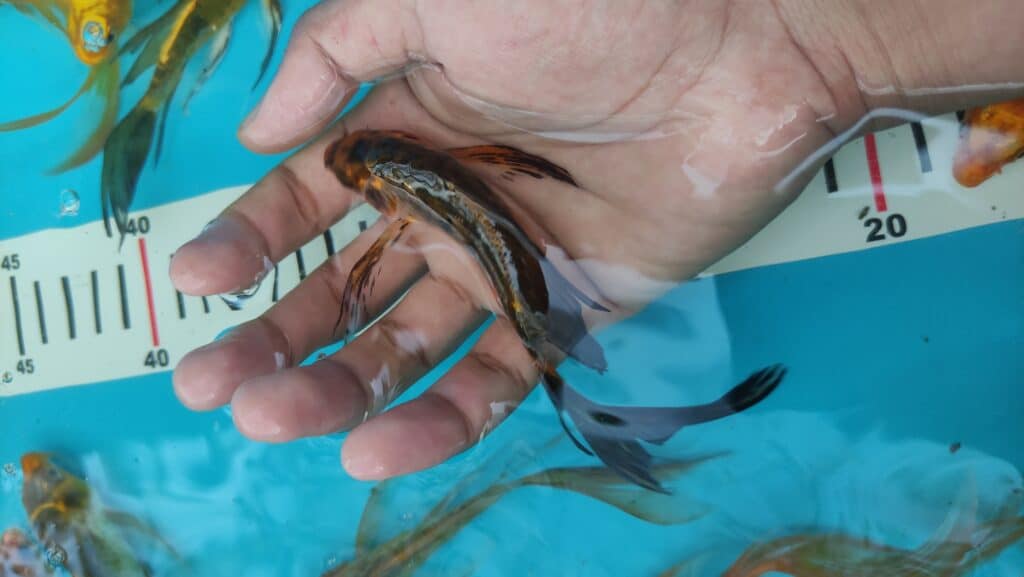
There is nothing more exciting have a new batch of freshly hatched baby Koi fish. Sometimes these new baby Koi might surprise you and look quite different from what you expected. But can baby Koi be born black?
Baby Koi fish often hatch devoid of color and can be black, white, or brown when they first hatch. The baby Koi will then begin developing colors and patterns as they grow. These colors can take several weeks to appear on the baby Koi fish, but it can take a few months.
Are black baby Koi fish rare? How many Koi fish eggs survive to hatch? How do you care for Koi eggs to help ensure most of the baby Koi survive? Let’s find out!
Pro Tip: If you’re tired of wasting money and making costly mistakes on the koi-keeping hobby or are thinking about buying koi fish but don’t know where to start, I strongly suggest you check out this ebook. I recently read this ebook, and it contains SO much useful information, such as:
- 3 proven steps to identify koi fish diseases
- WARNING: 3 things you should NEVER do when it comes to caring for koi
- When to seek professional help when it comes to looking after your koi
Can Baby Koi Fish Be Born Black?

Having baby Koi hatch in your care can be an exciting time for any Koi fish owner. Baby Koi fish are cute and tiny when they first hatch, and they can often have strange colorings that you are most likely not going to see in your adult Koi.
Baby Koi fish often hatch devoid of color and can appear black, white, or brown in their first few weeks of life. After which, most baby Koi will start developing some colors and patterns resembling the colors and patterns of their parents.
So, baby Koi fish can be black when they first hatch, which can surprise new Koi breeders. However, this is nothing to fear and is perfectly normal for baby Koi.
Are Black Baby Koi Rare?
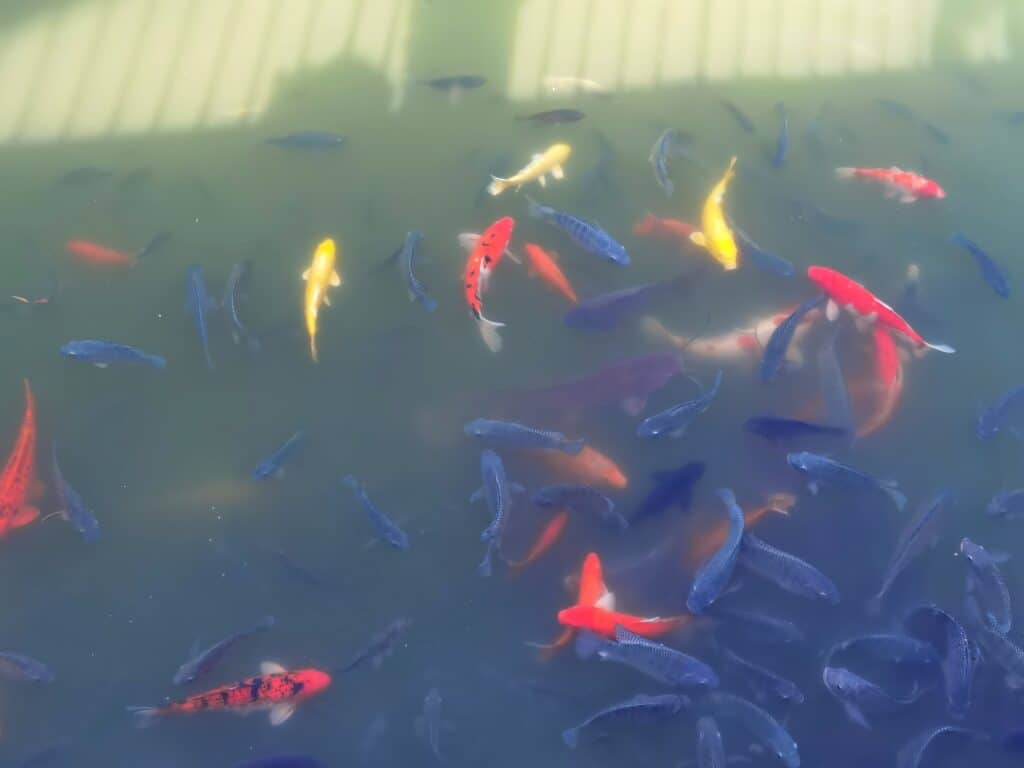
There are some cases where the baby Koi fish do not gain any color and remain black throughout their lives. There is only one variety in the Koi fish species that are considered truly black Koi fish. This is the Karasugoi Koi fish.
This Koi fish has been bred for centuries by Japanese Koi fish breeders, but these Koi fish are largely unknown in western countries. So, if you have a Karasugoi Koi fish in a western country, then your black Koi fish is a rare find.
However, if your baby Koi fish hatches black, this doesn’t mean it will remain black to adulthood. As mentioned earlier, Koi fish are devoid of color as fry and can hatch black, meaning this is not a rare color for baby Koi, but it is a rare color for adult Koi, especially if they are fully black.
What Do Baby Koi Fish Look Like?
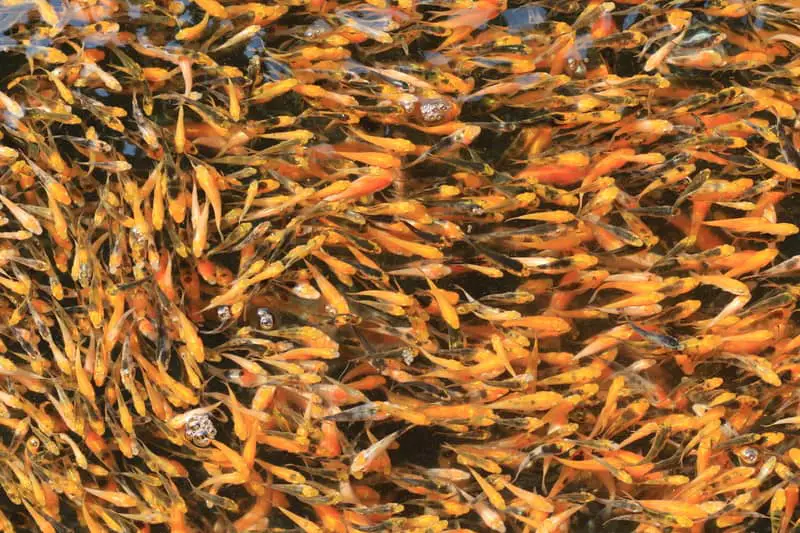
Baby Koi fish are known to be cute, but if you have never seen a baby Koi fish before and now have Koi eggs, you might be wondering what your little Koi babies will look like.
Baby Koi fish, also known as Koi fry, look like the smaller version of an adult Koi, except some would argue that they are a lot cuter than the adults. The only exception is that the baby koi will lack the adult Koi’s colorful patterns, as these will develop later in life.
How Many Koi Eggs Survive?
Even though it can be exciting to have some Koi eggs to care for, you need to know and understand that not all the Koi eggs will survive into the hatching faze. This is unfortunate, but it’s a part of life as some eggs might not get fertilized, some might be aborted due to disabilities, and others might get eaten before you take them out of the pond.
So, how many Koi eggs can you expect to survive? First, we need to look at how many eggs you can expect from your female Koi. The weight of the female generally determines this. For every 1-pound the female Koi weighs, she could produce 50,000 eggs.
So, a 2-pound female Koi can lay 100,000 eggs in one spawning season. This might sound like many eggs, but only about 60% of these eggs will survive to hatch into Koi fry. So, from an egg drop of 100,000 eggs, only 60,000 will hatch. From there, even less will survive the fry stage of life.
How To Take Care Of Koi Eggs?
So, female Koi fish drop many eggs when it’s breeding season, but how do you take care of all these eggs correctly? If you want all your baby Koi fish to hatch, survive, and grow into strong and healthy adult Koi, you can do a few things to ensure their safety.
To ensure that all your baby Koi fish survive to adulthood, you cannot keep them in your pond with adult Koi fish for reasons we will cover later in this article. Let’s go through how you can keep your baby Koi fish healthy, happy, and alive, so they can join your adult Koi fish in the big pond later.
Prepare A Spawning Tank For The Koi Eggs
When you know that Koi spawning season is coming up or if you bought baby Koi and you will be receiving them soon, you need to start preparing a spawning tank for the Koi eggs or baby Koi. This can be set up with a normal aquarium tank with a pump and filter.
You should make sure that the water in the tank is kept in the perfect living conditions for Koi fish. This means that you might want to start your spawning tank preparations early to ensure all eggs and baby Koi requirements are met.
When it’s spawning season, and the water in the tank is perfect, you have to switch the filter in the spawning tank off as this could damage the eggs and Koi fry that hatch, but you will be able to turn it back on later.
Remove The Fertilized Eggs From The Pond Or Tank
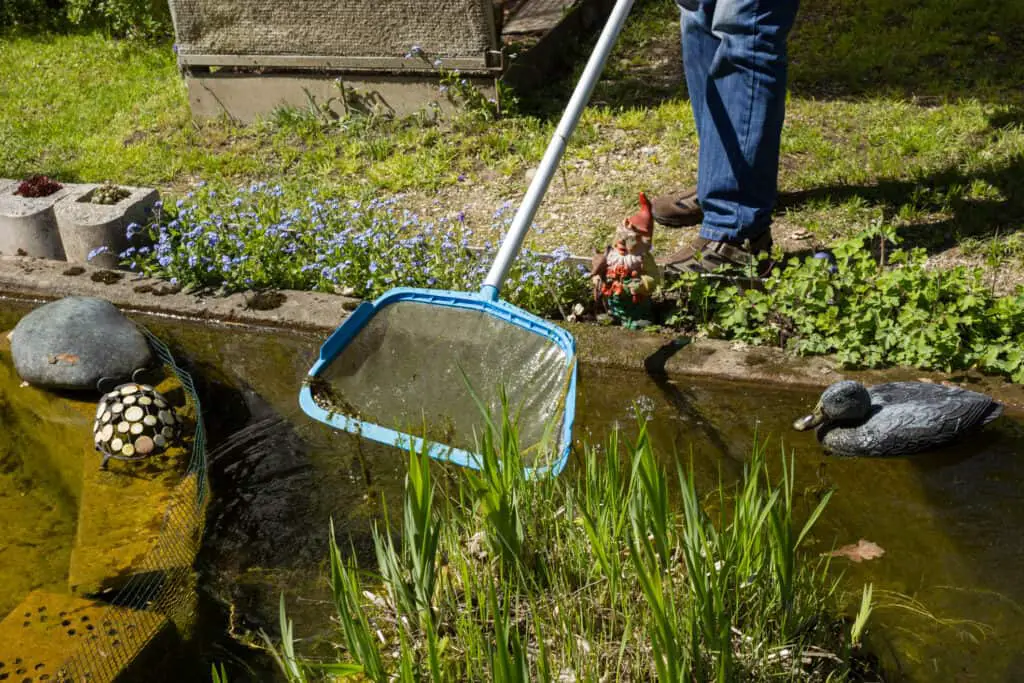
When the spawning season arrives and your female Koi drop their eggs, or you finally receive the baby Koi your bought, you will need to take the eggs out of the pond after they have been fertilized and move them into the spawning tank you have prepared.
Moving the Koi eggs into the spawning tank will give the Koi fry a safe place to hatch and develop without the risk of them being eaten. Keeping them in this tank will allow them to stay safe while they grow and grow into healthy and strong adult Koi.
This can be challenging for people with ponds as ponds can be deep, making it difficult to get to the Koi eggs before they hatch, but you should try your best if you want all the baby Koi to survive.
Keep The Spawning Tank At A Constant Temperature
Once you have the Koi eggs or baby Koi in the spawning tank, you need to keep the water’s temperature constant to help keep the eggs and Koi fry healthy. This temperature can be between 65 and 75°F.
Keeping the water in the tank in this temperature range will ensure the baby Koi can stay healthy and begin to grow and thrive in the tank without any complications arising.
Keep The Spawning Tank Clean
Once you have the Koi eggs or Koi fry in the spawning tank, you need to clean the tank. Even though the filter in the tank is switched off, you need to keep the water as clean as possible and ensure the ammonia levels in the water are low.
If the water and tank are not kept clean and the ammonia levels spike, this can start causing health problems with your baby Koi that are easier to prevent than treat.
About 24 hours after your baby Koi hatch from their eggs, you need to take out any remaining parts of the eggs left behind as you don’t want them to start decaying. This will dirty the water and begin to cause problems in the tank.
What To Do When The Koi Fry Hatch
If you are dealing with Koi eggs and they finally hatch in the spawning tank, what do you do now? When the baby Koi first hatch, you will not need to do anything for them in the first 24 hours of hatching.
It is recommended that you leave the baby Koi alone during this time. This will allow the baby Koi fish to recover from hatching and become accustomed to their new environment in their spawning tank.
After this first day, you will need to supply the baby Koi fish with food. Apart from this interaction, you should avoid disturbing the Koi too much as they are still very young and will get scared.
After the first two to three days, you can begin clearing out the leftover egg pieces and placing in some new plants and rocks to provide places for the baby Koi to hide. This will help the baby Koi feel more comfortable and relaxed in their tank.
How To Feed The Koi Fry
Knowing how to care for the eggs and baby Koi fry’s environment is only one part of the equation when caring for these tiny baby fish. You also need to know how to feed these babies and what to feed them to help them grow into robust and healthy adult Koi fish that can survive in your garden pond.
So, let’s go through what and how to feed your newborn baby Koi fish throughout the first months of their lives to ensure they don’t develop any complications due to lack of nutrition or being fed the wrong foods at the wrong time.
Birth To One-Month-Old
When Koi fish first hatch from their eggs, they will have a yolk. The yolk will sustain the baby Koi for about 24 hours after the baby’s hatch. After these 24, you will need to feed your baby Koi fish for the first time.
When it’s time for the first feeding, you need to remember that these koi fish babies are tiny, and they have very small mouths that you need to adapt the food to for them to eat it comfortably.
These babies have some specific nutritional requirements that you need to provide to them to help them grow strong and healthy.
The food you feed your baby Koi fish needs to be high in fat and proteins. These babies are growing very quickly, and these two specific nutrients will help support this growth.
For the first few days of your baby Koi’s life, you should use either a suspended-partial food or liquid food for them. This food is a form of larvae suspended in a fluid and is a lot easier for baby Koi to eat. These two food options are packed full of fats and proteins essential to the baby Koi’s growth.
Alternatively, for the first few feeds of your baby Koi, you could use a powdered food option with high quantities of fats and proteins. There are some specially made powdered food for baby Koi fish on the market that should be easy to find.
If you cannot find powdered food, you can buy some high-quality Adult Koi fish food and grind it into powder. This will still provide the babies with the nutrition they need.
Here is a guide on what to feed your baby Koi fish in the first month of their lives:
- Twenty-four hours after the baby Koi hatch, feed them liquid foods or suspended-particle food.
- For days 2 and 3, you can increase the portion sizes of their suspended-particle meals. You can add some newborn brine shrimp into the baby Koi’s diet but only do this once a day.
- For days 4 and 5, you can start feeding them a quarter cup of egg yolk paste once a day, in conjunction with their usual suspended-particle food. You can make this egg yolk paste at home.
- On days 6 and 7 of your Koi’s lives, you can add powdered food into your baby Koi’s diet.
- In the second week of your baby Koi’s life, you can start feeding them crushed adult Koi pellets, along with some daphnia that you can find at your local aquarium store.
- At the end of this second week, stop feeding the baby Koi liquid foods and the egg paste. Switch to some good-quality powdered fish flakes and krill. Continue providing your baby Koi baby brine shrimp with the flakes for added protein and the daphnia.
Two Months Old
When your baby Koi reaches the two-month mark, you can begin to celebrate as this is a big milestone because you can finally turn on the tank’s filter to help you keep the tank clean. Your baby Koi will now be big enough to swim against the slightly strong pull of the filter’s current.
When your baby Koi has reached this milestone, they should measure about 1 or 2 inches in length. You may notice that a few of your baby Koi fish are stronger and somewhat bigger than the others. These baby Koi might hog the food during your feedings, so you need to watch them.
Alternatively, you can remove these baby Koi and place them in a separate tank to allow the other smaller baby Koi to feed better. For the second, you can feed your baby Koi the following:
- Powdered baby Koi fish flakes
- Baby Koi sinking pellets; once a day
- Frozen daphnia
- Crushed adult Koi fish pellets
- Frozen brine shrimp, the ones with the adult shrimp.
Three Months Old Koi Fish
When your cute baby Koi fish finally reaches the three-month mark, you can drop one feeding time as the baby Koi won’t need to eat as often anymore. You should ensure the babies eat three times a day. Allow your baby Koi to each as much as possible in a 5-minute window.
When your baby Koi fish are three months old, you should start changing their diet slightly. When the baby fish are this old, you should still feed them the same pellet foods you were feeding them in their second month of life, but you will only need to feed them the frozen daphnia once per day now.
The rest of the food you give the baby Koi will be the same as what you fed them at their two-month milestone. When the third month is up, which will fly by pretty fast, your baby Koi should measure between 3 to 4 inches. You can start feeding your baby Koi the same way you feed your adult Koi fish when this month is up.
How Many Times Should A Baby Koi Be Fed In A Day?
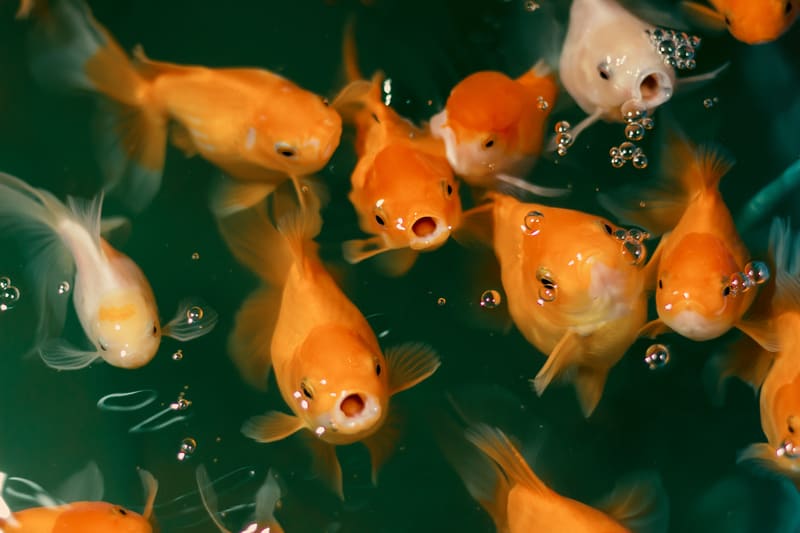
Baby Koi fish are like many animals on the planet, meaning that the younger they are, the more often they need to eat. This is because they are still growing and growing at a fast pace into strong and healthy adults.
Koi fish grow quickly, so they need to be fed frequently enough to help sustain this fast growth, or they could develop disabilities later due to lack of nutrition, affecting how they swim as adults.
After 24 hours, you need to feed them four times a day. This can be challenging for some people due to work and life obligations, but this regular feeding supports their growth well and gives them the best start in their lives.
When your baby Koi are three months old, you can cut one feeding session out and bring their feedings to three times a day. Your baby Koi are not growing as fast as they did in their first two months once they reach this age.
Professional Koi breeders recommend that you still feed your baby Koi three times a day until they reach four months old. Once they are this age, you can feed them as frequently as your adult Koi fish.
How Much Should You Feed Baby Koi?
So, now that you know what to feed your baby Koi fish and how often to feed them, you might be wondering how much you should feed them throughout each stage of their lives as they are growing.
When your baby Koi are under one month old, you will need to experiment with the amount of food your baby Koi needs to eat as all baby Koi are different and will require different amounts of food.
When you do this, you should focus on fine-tuning the amount to make sure you don’t overfeed the baby fish at a young age.
Unfortunately, there is no set amount by professionals that you should be feeding your baby Koi. You will need to feed the baby Koi fish in small amounts at first and then see if they still look hungry. If they are, you can feed them a bit more and repeat this process until the baby Koi are satisfied. This is a good way to gauge the amount they need to grow strong and healthy.
If you find this task challenging, you should speak to a professional Koi fish breeder and have them look at your baby Koi. They will help you determine the perfect amount of food your baby Koi fish needs.
Why You Need To Create A Spawning Tank
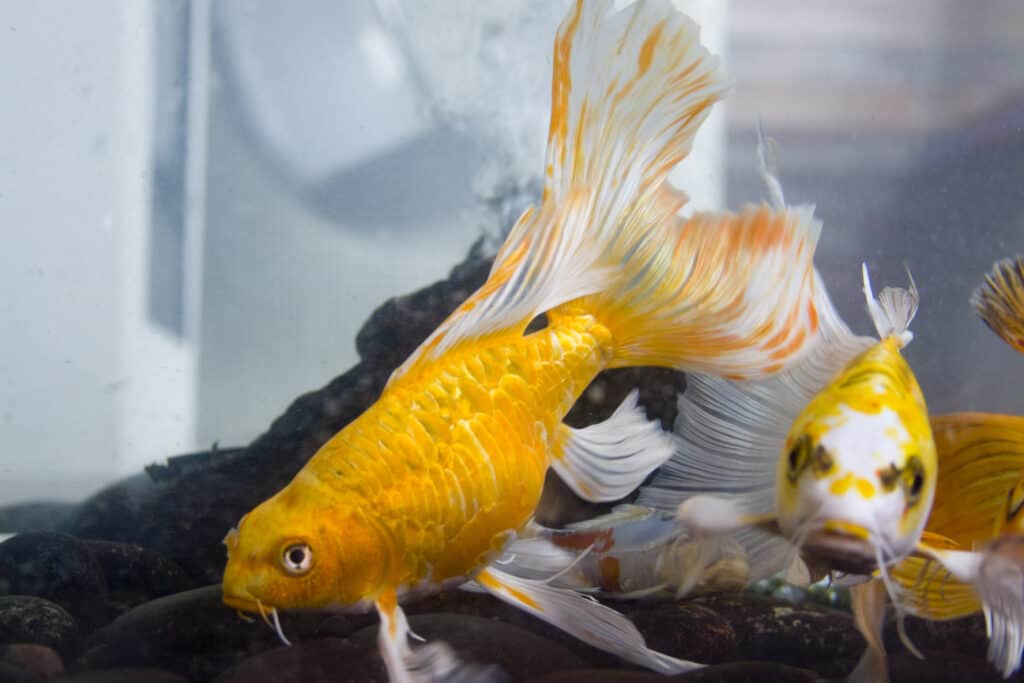

Having a spawning tank prepared for your baby Koi is an important aspect of Koi egg care, and you should have the spawning tank ready a week or two before your female Koi fish begin dropping their eggs.
If you were unprepared for the baby Koi and did not have a spawning or nursery tank ready before the baby Koi hatched, you might be worried about the survival of the new baby Koi in your pond, and rightly so.
The main fear when leaving baby Koi that have just hatched in the pond with adult Koi fish is that the adult Koi are well-known to be cannibalistic. Adult Koi will eat the baby Koi if they come across their path in the pond.
Adult Koi fish will also eat the eggs before they hatch if they are unprotected. Some female Koi fish will even eat their own eggs. This is the main concern when leaving baby Koi in a pond with adult Koi.
However, baby Koi can survive in the same water conditions that adult Koi fish thrive in, so if some of the baby Koi survive and are not eaten, they can survive in a pond with adult Koi fish.
Conclusion
Baby Koi are tiny little creatures that look like miniature versions of adult Koi fish. These baby fish can be black when they first hatch, but they usually start developing colors and patterns as they grow.
The important thing is to help these little creatures survive and reach adulthood by providing them with everything they need to grow. If you follow the baby Koi care guidelines in this article, you should have many happy, strong, and healthy baby Koi fish on your hands. Good luck with your baby Koi!
References
https://theinfinitekitchen.com/faq/quick-answer-what-do-baby-koi-carp-look-like/
https://findanyanswer.com/can-koi-be-black
https://www.fitzfishponds.com/blog/what-you-should-know-about-black-colored-koi/
https://totallykoi.com/a-guide-to-koi-fry-colors/
https://www.fishkeepingwisdom.com/how-often-do-koi-fish-lay-eggs/

